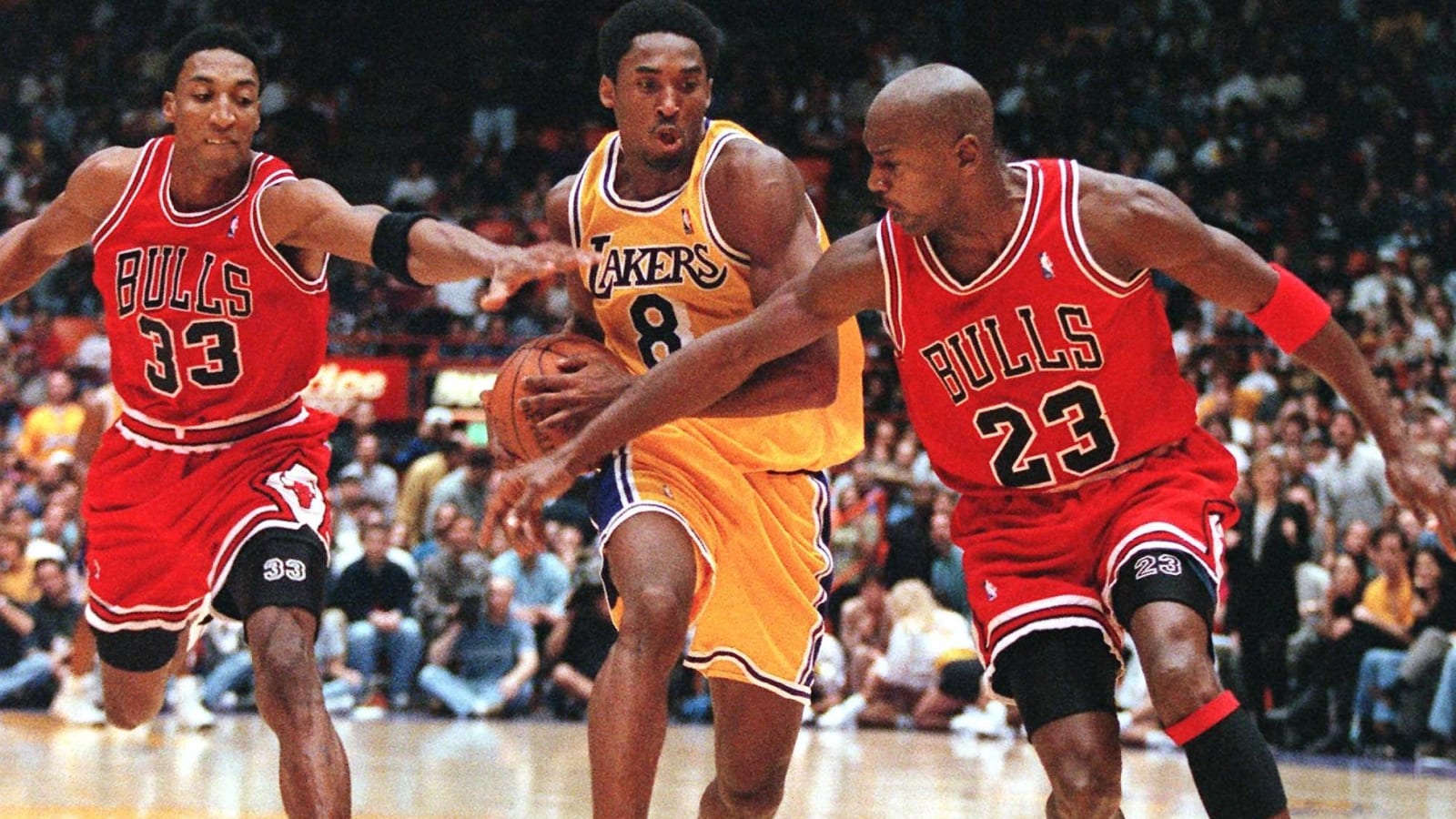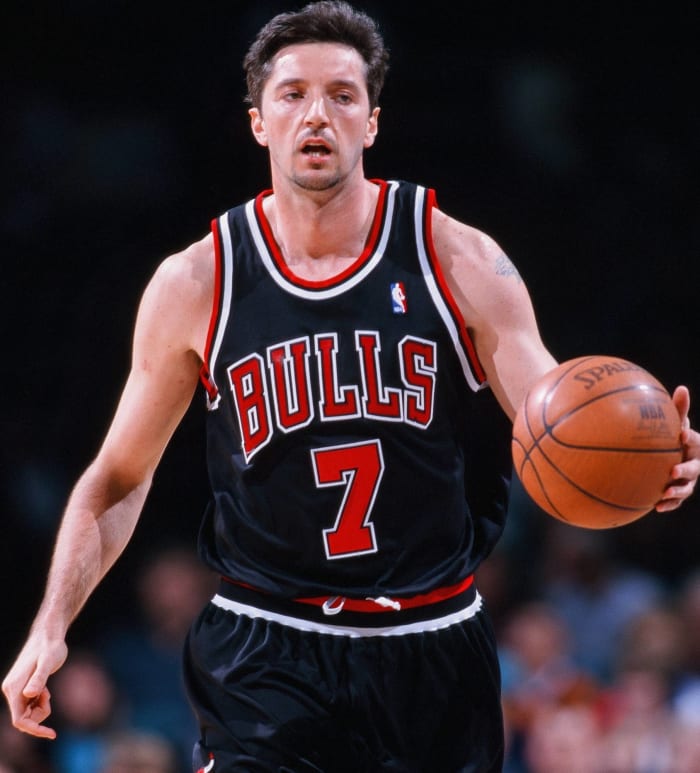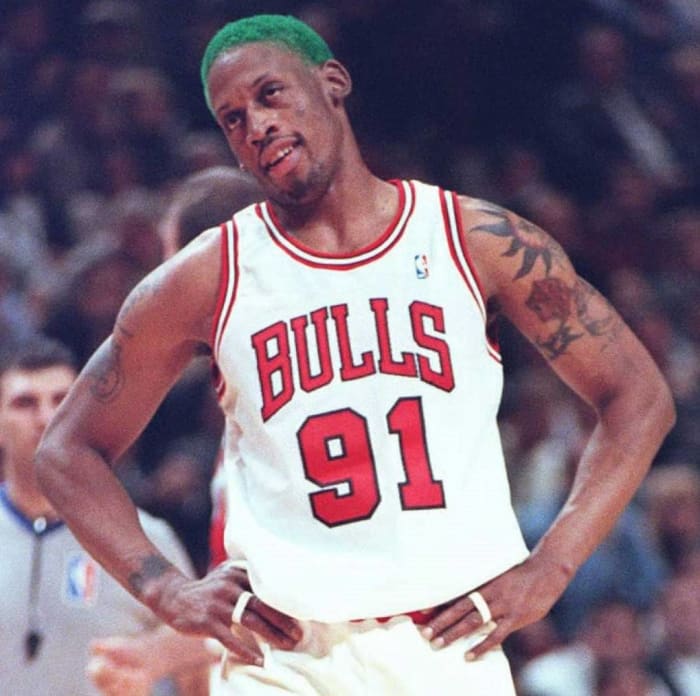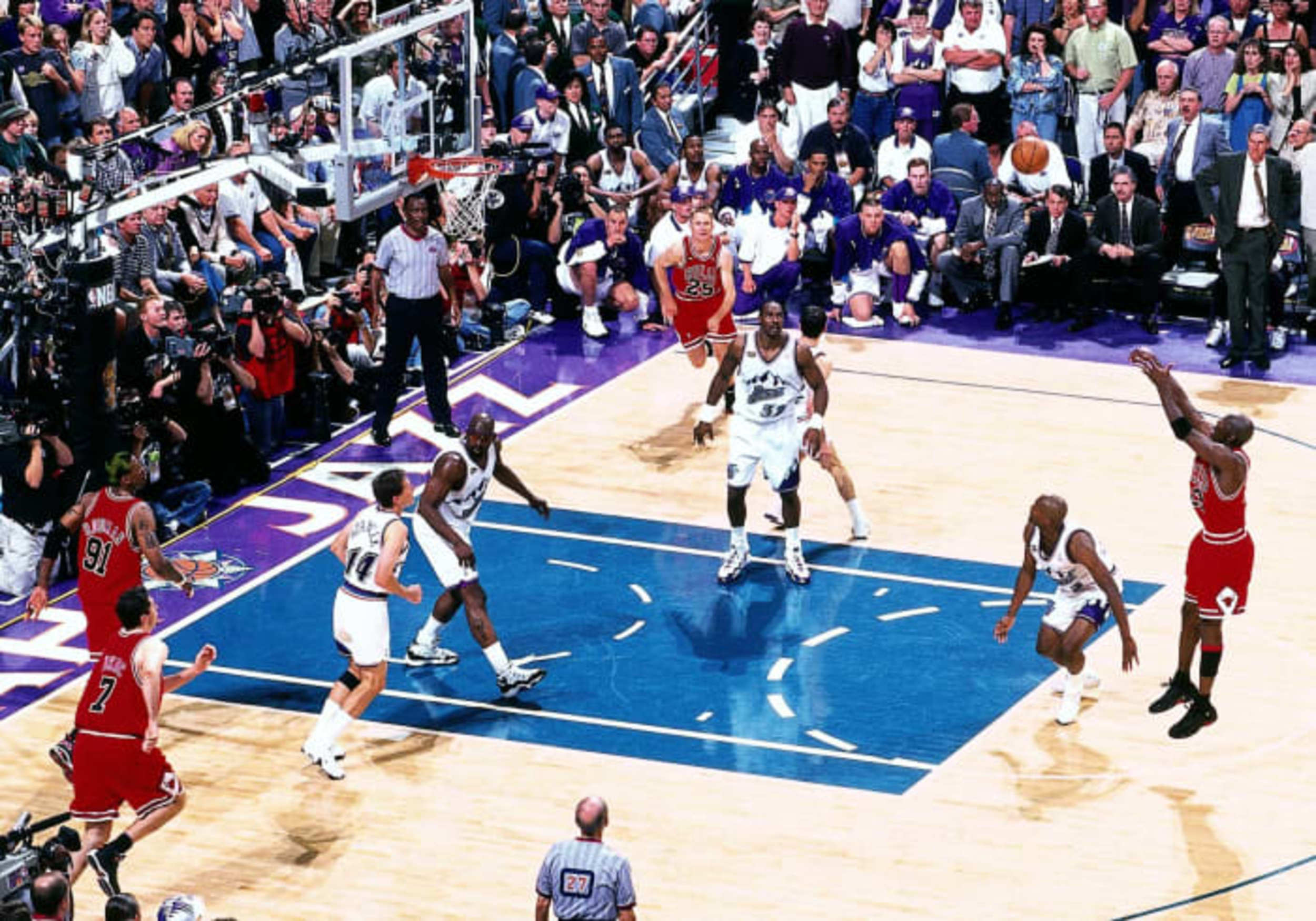
How 'The Last Dance' Bulls would fare in today's NBA
As we eagerly anticipate the remaining episodes of “The Last Dance” on ESPN, the endless “MJ vs. LeBron” debates on talk shows and social media drone on. And while these hot take topics are as nauseating as they are repetitive, there is one spin-off topic that I find fascinating:
How would Michael Jordan’s “Last Dance” Bulls of 1997-98 have fared if they played in today’s NBA?
ROSTER/STATS: 1997-98 Bulls (62-20, NBA champs)
The answer is a lot more nuanced than some might think — any talking head who scoffs at this question with some blanket statement like “MJ would average 50 points a game today and the Bulls would go 74-8” is not worth your attention. Many of the Bulls’ main rotation players did not have the requisite skills to play in the NBA in 2020. The team would have to adapt to the modern rules, pace-of-play and analytically driven strategies of opponents — not to mention compete in a much more talented league.
This isn’t to suggest they wouldn’t be a championship-caliber team, but there’s a lot to consider with this prompt.

Roster projections – the good
If any team from the late-'90s era could compete in today's NBA, it would be the Bulls, a team ahead of its time in many ways.
Unlike most '90s-era teams, which were built around the league’s best post players, the Bulls were structured around two elite wings: Jordan and Scottie Pippen. This would make them right at home in today’s NBA, in which the best teams — Lakers, Clippers, Bucks — revolve around some of the game’s best wings and forwards (LeBron James and Anthony Davis, Kawhi Leonard and Paul George, Giannis Antetokounmpo and Khris Middleton).
ROSTER/STATS: 1997-98 Bulls (62-20, NBA champs)
Jordan and Pippen would be the best wing combination in the NBA today. Though they were older than Kawhi (28) and George (29), Jordan (34) and Pippen (32) would probably have a slightly larger impact in terms of two-way play. In fact, if you look at Jordan-Pippen’s combined per-game production (47.8 points, 11 rebounds, 9.3 assists, 3.5 steals, and 1.5 blocks), it’s eerily similar to Kawhi-George’s (47.9 points, 13 rebounds, 8.9 assists, 3.1 steals, and 1.1 blocks). But that’s without adjusting for the pace and efficiency-driven style of play (discussed below), which would inflate Jordan and Pippen’s combined stats. Their slight superiority in this comparison is further demonstrated by their respective net ratings per 100 possessions — Jordan was a plus-14 and Pippen was a plus-13, compared to Leonard, a plus-12, and George, a plus-6.

The Bulls would also thrive in today’s positionless, spread-out game with their versatility at forward. For all of his off-the-court issues, Dennis Rodman had the type of defensive impact that would compare favorably to the Warriors’ Draymond Green — this would allow the Bulls to play small-ball with him at center. In addition to being able to guard any position and body type, Rodman was also a genius-level rebounder (15 per game) and had a knack for extending the Bulls’ possessions with offensive boards (5.3 per game).
At the other forward, Toni Kukoč would thrive in today’s game because he was the prototypical stretch-forward (6-foot-10, averaging 13.3 points on 46-36-71 shooting splits) before anyone knew how impactful that type of player could be. Instead of shooting only 2.4 three-pointers a game as he did in '97-98, Kukoč would play more like the Thunder’s Danilo Gallinari and launch 7.3 three-pointers per game. Kukoč was also an excellent passer (second on the Bulls with 4.2 assists per game), and a more up-tempo, spread-out offensive approach would put more emphasis on that unique skill. He’d probably be a borderline All-Star today.
Steve Kerr would also benefit from playing in 2020, as his elite shooting would be a much more important skill than it was in 1998. Despite shooting 43.8 percent from three in 1997-98, Kerr attempted only 2.6 three-pointers per game. While his size (6-foot-3) and athletic limitations would make it difficult for the Bulls to play him more than his 22.4 minutes per game in '97-98, he would likely be used like the Cavs, Jazz and Bucks have used Kyle Korver in recent years. Every possession, he’d be coming off screens and hunting threes, shifting the gravity and attention of the defense, further spacing the court for Jordan and Pippen.

Roster projections – the bad and ugly
Unfortunately for the Bulls, other than Scott Burrell, who shot a respectable 35.4 percent from three and had some versatility as a small forward, none of the other players on the roster would be nearly as effective today. In fact, none of the rest of the roster would have any business playing in the current NBA.
ROSTER/STATS: 1997-98 Bulls (62-20, NBA champs)
Ron Harper was an excellent defensive guard and great veteran, but having 44-19-75 shooting splits and limited court vision (2.9 assists per game) would keep him out of the rotation on the Windy City Bulls (Chicago’s G-League affiliate). Harper’s backup? Randy Brown shot 38.4 percent from the field and zero percent from three. And we thought Ben Simmons couldn’t shoot!
Don’t get me started on the Bulls’ Jurassic situation at center. The 1997-98 season was slow-footed center Luc Longley’s finest year -– he averaged 11.4 points, 5.9 rebounds and 1.1 blocks. But dig a little deeper and you’ll discover that he’s 7-foot-2 and only shot 45.5 percent from the field. Talk about a stiff! Longley’s backup was Bill Wennington. He’s 7-foot and shot 43.6 percent from the field. Wennington would have trouble playing professional basketball in the Northern Hemisphere in 2020.

Adjusting to today’s NBA
If “The Last Dance” Bulls had to play in today’s NBA, they would be the ones making adjustments and not the other way around. For one, they would have some trouble getting used to the new rules — particularly the hand-checking fouls and focus on offensive freedom-of-movement. While this would theoretically make Jordan, Pippen, Kukoč and Kerr more productive on offense, it would likely have a negative impact on the Bulls' physical, suffocating defense (third-best defensive rating in NBA).
Adjusting to the pace of play would be another obstacle, as the Bulls were the seventh-slowest team in the 1997-98 season, averaging 89 possessions per game. The slowest team in the NBA this season was, ironically, Jordan’s Hornets, which averaged 99.8 possessions per game. Even if the Bulls were the slowest team in the league, that’s at least 20 additional possessions (10 on offense; at least 10 on defense) that they’d have to account for today.
Considering what we now know about sports science, it’d be risky for Jordan to play 82 games and average nearly 39 minutes per game at a modern pace. Same goes for Pippen (37.5 minutes per game) and the 36-year-old Rodman (35.7 mpg.). Those per-game totals would be first, second and ninth in 2020. With such a dismal bench, Phil Jackson would have quite the conundrum on his hands: Play this trio the same amount and risk them getting injured and worn down in the playoffs? Or spread their minutes among the awful bench rotation and finish with a worse regular-season record and playoff seed?
Finally, the Bulls would have to embrace analytically driven basketball, aimed at maximizing the most efficient shots — three-pointers, free throws and layups — and deemphasizing the mid-range game. This would present some serious problems for the Bulls and their 32.3 percent shooting on 11.7 three-point attempts per game. This season, the Hawks had the lowest three-point percentage (33.3) and the Pacers had the fewest three-point attempts per game (27.5). The Bulls simply wouldn’t be competitive if they continued to shoot less than 12 threes a game.
While Jordan could still dominate the extended post and mid-range, especially late in games, he’d have to shoot a hell of a lot more threes than he did back then (1.5 per game) and at a much higher clip (23.8 percent) to be as unstoppable a player as he was in 1997-98. And with more threes would come more opportunities for rolls to the basket and screen slips for Rodman — but he’d have to finish a heck of a lot better than he did back then when he shot an abysmal 41.7 percent on shots from 0-3 feet from the basket. The great ones always find a way, but having to completely change the way you’ve always played basketball isn’t something that happens overnight.

Bottom line
For all of the adjustments they’d have to make, the Bulls would still have the top-end talent to compete in today’s game. Their net rating per 100 possessions (plus-8.9) would be good for second in the league, sandwiching them between the two best regular-season teams — the Bucks (plus-10.7) and Lakers (plus-7.1). Offensively, the team would put the ball in the hands of Jordan (33.7 usage rate) and Pippen (24.4 usage rate) even more than it previously did and destroy defenses with MJ isolations and pick-and-pops with Kukoč.
Defensively, Jordan, Pippen and Rodman would presumably still be three of the best defenders in the league. However, they would be tasked with making up for the athletic limitations of Kerr as well as the team’s complete lack of rim protection. They could address those issues by playing Harper and Longley more minutes, but the trade-off would be that both are absolute zeros on offense in today’s game.
The Bulls would close games with their own version of the Lineup of Death: MJ, Pippen, Rodman, Kukoč and Kerr. This would likely be the best five-man lineup in the league — it even had a plus-13.6 net rating back in 1997-98. At the same time, Phil Jackson would have to be careful with how frequently he used this lineup so as to not wear them out during the regular season.
In the end, the Bulls would find today’s NBA to be much more competitive than it was in 1997-98 when five teams finished with 20 or fewer wins. Had there been 82 games in 2019-20, only one team would have been in jeopardy of winning fewer than 20 games. The increase in league-wide competence, combined with the ineffectiveness of the Bulls’ bench, would have likely resulted in a 50-55 win regular season and anywhere from a three to six-seed in the Eastern Conference playoffs.
Yet, if their top-end talent was healthy during the playoffs –- and this is a big “if” when you recall how banged-up Pippen and Rodman were in the 1998 Finals — Jordan would will them to a deep playoff run and challenge the Bucks, Lakers and Clippers for NBA supremacy. But make no mistake, it would require a G.O.A.T. kind of performance to win it all.
More must-reads:
- Steve Kerr says Michael Jordan left Bulls for baseball because he was emotionally 'fried,' says teammates didn't resent Scottie Pippen
- Dennis Rodman: Scottie Pippen 'was the best player in the world' during Michael Jordan's hiatus
- The 'Most points in a playoff game by team' quiz
Breaking News
Customize Your Newsletter
 +
+
Get the latest news and rumors, customized to your favorite sports and teams. Emailed daily. Always free!

